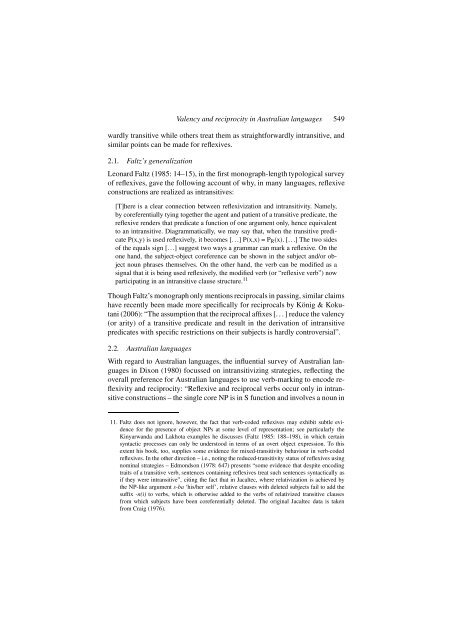Valency mismatches and the coding of reciprocity in ... - Linguistics
Valency mismatches and the coding of reciprocity in ... - Linguistics
Valency mismatches and the coding of reciprocity in ... - Linguistics
Create successful ePaper yourself
Turn your PDF publications into a flip-book with our unique Google optimized e-Paper software.
<strong>Valency</strong> <strong>and</strong> <strong>reciprocity</strong> <strong>in</strong> Australian languages 549<br />
wardly transitive while o<strong>the</strong>rs treat <strong>the</strong>m as straightforwardly <strong>in</strong>transitive, <strong>and</strong><br />
similar po<strong>in</strong>ts can be made for reflexives.<br />
2.1. Faltz’s generalization<br />
Leonard Faltz (1985: 14–15), <strong>in</strong> <strong>the</strong> first monograph-length typological survey<br />
<strong>of</strong> reflexives, gave <strong>the</strong> follow<strong>in</strong>g account <strong>of</strong> why, <strong>in</strong> many languages, reflexive<br />
constructions are realized as <strong>in</strong>transitives:<br />
[T]here is a clear connection between reflexivization <strong>and</strong> <strong>in</strong>transitivity. Namely,<br />
by coreferentially ty<strong>in</strong>g toge<strong>the</strong>r <strong>the</strong> agent <strong>and</strong> patient <strong>of</strong> a transitive predicate, <strong>the</strong><br />
reflexive renders that predicate a function <strong>of</strong> one argument only, hence equivalent<br />
to an <strong>in</strong>transitive. Diagrammatically, we may say that, when <strong>the</strong> transitive predicate<br />
P(x,y) is used reflexively, it becomes [...]P(x,x)=PR(x). [...] The two sides<br />
<strong>of</strong> <strong>the</strong> equals sign [...] suggest two ways a grammar can mark a reflexive. On <strong>the</strong><br />
one h<strong>and</strong>, <strong>the</strong> subject-object coreference can be shown <strong>in</strong> <strong>the</strong> subject <strong>and</strong>/or object<br />
noun phrases <strong>the</strong>mselves. On <strong>the</strong> o<strong>the</strong>r h<strong>and</strong>, <strong>the</strong> verb can be modified as a<br />
signal that it is be<strong>in</strong>g used reflexively, <strong>the</strong> modified verb (or “reflexive verb”) now<br />
participat<strong>in</strong>g <strong>in</strong> an <strong>in</strong>transitive clause structure. 11<br />
Though Faltz’s monograph only mentions reciprocals <strong>in</strong> pass<strong>in</strong>g, similar claims<br />
have recently been made more specifically for reciprocals by König & Kokutani<br />
(2006): “The assumption that <strong>the</strong> reciprocal affixes [...]reduce<strong>the</strong>valency<br />
(or arity) <strong>of</strong> a transitive predicate <strong>and</strong> result <strong>in</strong> <strong>the</strong> derivation <strong>of</strong> <strong>in</strong>transitive<br />
predicates with specific restrictions on <strong>the</strong>ir subjects is hardly controversial”.<br />
2.2. Australian languages<br />
With regard to Australian languages, <strong>the</strong> <strong>in</strong>fluential survey <strong>of</strong> Australian languages<br />
<strong>in</strong> Dixon (1980) focussed on <strong>in</strong>transitiviz<strong>in</strong>g strategies, reflect<strong>in</strong>g <strong>the</strong><br />
overall preference for Australian languages to use verb-mark<strong>in</strong>g to encode reflexivity<br />
<strong>and</strong> <strong>reciprocity</strong>: “Reflexive <strong>and</strong> reciprocal verbs occur only <strong>in</strong> <strong>in</strong>transitive<br />
constructions – <strong>the</strong> s<strong>in</strong>gle core NP is <strong>in</strong> S function <strong>and</strong> <strong>in</strong>volves a noun <strong>in</strong><br />
11. Faltz does not ignore, however, <strong>the</strong> fact that verb-coded reflexives may exhibit subtle evidence<br />
for <strong>the</strong> presence <strong>of</strong> object NPs at some level <strong>of</strong> representation; see particularly <strong>the</strong><br />
K<strong>in</strong>yarw<strong>and</strong>a <strong>and</strong> Lakhota examples he discusses (Faltz 1985: 188–198), <strong>in</strong> which certa<strong>in</strong><br />
syntactic processes can only be understood <strong>in</strong> terms <strong>of</strong> an overt object expression. To this<br />
extent his book, too, supplies some evidence for mixed-transitivity behaviour <strong>in</strong> verb-coded<br />
reflexives. In <strong>the</strong> o<strong>the</strong>r direction – i.e., not<strong>in</strong>g <strong>the</strong> reduced-transitivity status <strong>of</strong> reflexives us<strong>in</strong>g<br />
nom<strong>in</strong>al strategies – Edmondson (1978: 647) presents “some evidence that despite en<strong>cod<strong>in</strong>g</strong><br />
traits <strong>of</strong> a transitive verb, sentences conta<strong>in</strong><strong>in</strong>g reflexives treat such sentences syntactically as<br />
if <strong>the</strong>y were <strong>in</strong>transitive”, cit<strong>in</strong>g <strong>the</strong> fact that <strong>in</strong> Jacaltec, where relativization is achieved by<br />
<strong>the</strong> NP-like argument s-ba ‘his/her self’, relative clauses with deleted subjects fail to add <strong>the</strong><br />
suffix -n(i) to verbs, which is o<strong>the</strong>rwise added to <strong>the</strong> verbs <strong>of</strong> relativized transitive clauses<br />
from which subjects have been coreferentially deleted. The orig<strong>in</strong>al Jacaltec data is taken<br />
from Craig (1976).

















